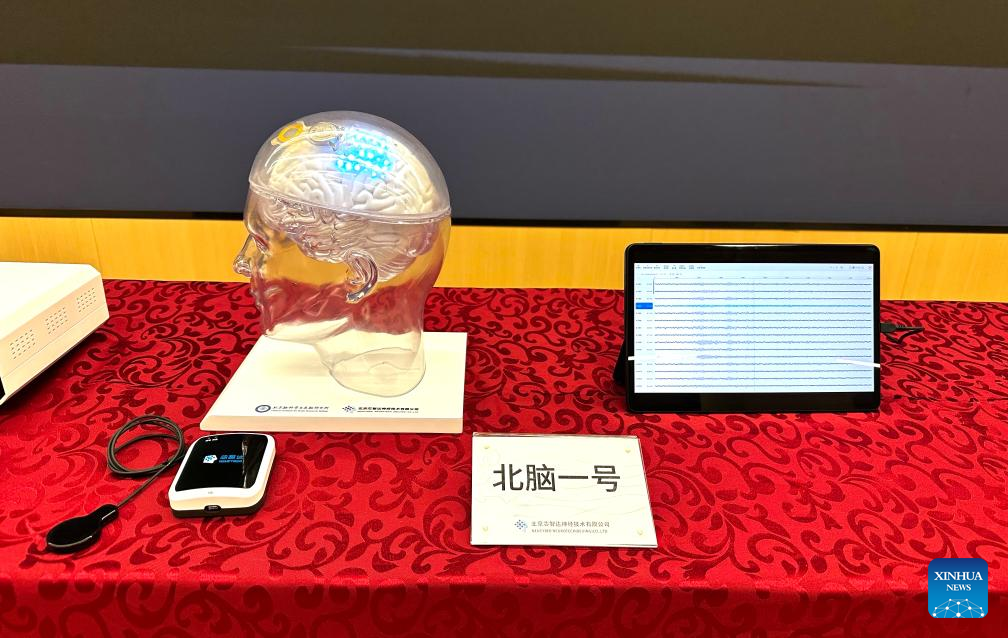
 0 Comment(s)
0 Comment(s) Print
Print E-mail Xinhua, March 21, 2025
E-mail Xinhua, March 21, 2025
This photo shows a semi-invasive brain-machine interface (BMI) at a press conference held by the Chinese Institute for Brain Research, Beijing (CIBR) and NeuCyber NeuroTech (Beijing) Co., Ltd. in Beijing, capital of China, March 20, 2025. [Photo/Xinhua]
A Chinese semi-invasive brain-machine interface (BMI) research team has successfully completed multiple cases of full cortical BMI implantation, enabling an aphasic patient to output Chinese language and paralyzed patients to control computers and robotic arms.
According to a Thursday press conference held by the Chinese Institute for Brain Research, Beijing (CIBR), as well as the Capital Medical University-affiliated Xuanwu Hospital and NeuCyber NeuroTech (Beijing) Co., Ltd., clinical evidence from the first cohort of patients implanted with the system demonstrated that over 98 percent of the BMI channels remain functional after the surgery.
The NeuCyber Matrix BMI System, a joint innovation by CIBR and NeuCyber, is a wireless BMI system featuring a thin, flexible nano-fabricated film microelectrode. It has a flux of 128-channel in semi-invasive device and is integrated with a compact micro-circuit for recording and processing electrocorticography (ECoG) signals.
According to the CIBR, for the first time, an aphasic patient has been able to output Chinese language through the semi-invasive BMI system, regaining the ability to communicate. The paralyzed patients are also successfully adapting to the system and using it to control external devices, compensating for their loss of motor function.
CIBR Director Luo Minmin said that to accurately interpret patients' ECoG signals, the system uses three key technologies. The first is a high-integration micro-host designed to process high-flux, low-power signals. The second is new-generation wireless short-range communication technology, which is used for low-power, high-bandwidth data transmission. And the third is a real-time, accurate and multi-scenario algorithm, which can decode fine movements and the Chinese language accurately.
Earlier this month, a team led by Xuanwu Hospital President Zhao Guoguang performed the world's first wireless Chinese-language BMI implantation surgery on a patient who had lost the ability to speak due to amyotrophic lateral sclerosis (ALS).
Assisted by a neurosurgical robotic system, the team precisely implanted the NeuCyber Matrix BMI System on the dura mater of the left side of the patient's brain -- the region responsible for language processing.
The surgery took a semi-invasive approach, positioning the electrode outside the dura mater to capture high-quality neural signals with minimal trauma, unlike invasive BMI surgery, which implants electrodes inside the brain.
A coin-sized control and signal transmission device was also embedded into the surface of the patient's skull, enabling efficient neural signal transmission and wireless power supply through near-field communication technology.
The patient began language decoding training on March 14, following the surgery. After just three hours, their real-time decoding accuracy for 62 commonly used words had reached 34 percent. That accuracy level has since improved to 52 percent, according to Zhao.
Aided by an adaptive error correction algorithm that is based on a large language model, the patient has already regained basic Chinese-language communication abilities. The system has decoded sentences such as "I want to drink water," "I want to eat," and "I'm in a great mood today. I'd like to take a walk with my family." The decoding latency for a single Chinese character is now below 100 milliseconds.
"BMI technology can help speech-impaired patients regain their communication abilities," said Li Yuan, business development director at NeuCyber NeuroTech (Beijing) Co., Ltd.
"With synthetic speech technology, what they want to say can even be heard," Li added.
Zhao said the surgery results suggest that semi-invasive BMI technology can provide a novel, long-term, stable language recovery solution for more aphasic patients, expanding the boundaries of this technology in the field of neurological disease diagnosis and treatment.
He said his team will continue to explore BMI-powered clinical practices for intractable epilepsy, spinal cord injury, stroke, ALS and aphasia.